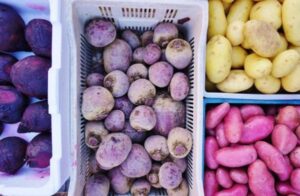6 Reasons You Want to Sign Up for a Winter CSA Share Now

Are you jonesing for your summer CSA share? Are tastes of fresh veggies fading faster than your summer tan? Fear not! A winter CSA share will keep the veggies coming in colder months. Still on the fence about whether or not to sign up for a winter CSA share? Here are six reasons you want one.
1. All those farm fresh veggies! You may be surprised by all that you’ll find in your weekly share. Expect to see staple winter veggies such as kale, bok choi, spinach, cabbage, leeks, turnips, broccoli, beets, potatoes, radish, and garlic. But you may also find some late season tomatoes, peppers, and squash depending on your farm’s storage facilities and where it is located. Dried herbs, beans, and wheat may also turn up in your share. Farms with fruit trees may offer apples. If you’re really lucky your farm will include extra-special items such as fermented pickles, frozen berries, honey, or maple syrup.
2. Eat healthy year ’round. If you’re anything like me, all those healthy veggies arriving at my home each week force me to eat more healthfully. A winter CSA share allows that nutritious eating to continue even though the season has changed. I’m not the only one who sees the link between CSA shares and healthy eating. Health insurance companies realize the importance of eating farm fresh produce. To encourage their members’ healthful habits some are offering rebates for CSA shares.
3. Try veggies you may not otherwise try. A winter CSA share offers veggies that you may not otherwise try. I ate (and loved) my first kohlrabi because it was in my CSA share. Sure, you may have eaten a radish before, but what about a Candela Di Fuoco radish or Chinese Red Meat radish? Because less common varieties of familiar veggies may turn up in your share you’re sure to discover flavors you’ve never tasted.
4. It’s economical. Depending on how many weeks your farm offers the winter CSA share, you can expect to pay between $300-$600 for your share. That may sound like a lot, but when you break it down on a week-by-week basis the price is much more reasonable. Many farms report offering more in their shares than what you pay for. In other words, if your weekly share costs $35 you may often find $40 worth of produce in that share. Most farms also offer half-shares for folks who can’t afford a full share or who use less produce. If money is tight for you, ask if your farm offers a “working membership/ working share” option where you can offer help on the farm in exchange for part or all of your CSA share.
5. Support local farms and the environment. When you order a winter CSA share you’re supporting family farms in your community–not big, factory farms. When a farm receives your CSA payment along with other members’ payments they have a significant one-time chunk of money with which to run their farm. That money allows them to pay large overhead bills such as repairing or purchasing equipment, buying seeds, or making payroll, to name only a few. As you know, when you buy locally produced produce you have a smaller carbon footprint because your produce didn’t travel hundreds of miles. Furthermore, if your farm uses organic practices then you’re supporting farmers who employ practices that nurture the land.
6. Community is an important part of CSA. Many farms see their CSA members as more than just consumers–they see them as a vital part of the farm community. That’s why farms offer ways for CSA members to join in the life of the farm and meet other CSA members. As a part of the farm community you may have the opportunity to gather for a farm meal, join in maple syrup harvesting, learn a new skill such as making kimchi, or take a winter sleigh ride. Are you new to your town or city? Purchasing a CSA share will not only provide you with farm fresh produce it is also an opportunity to meet new neighbors who share in your love of healthful eating.
Related on Organic Authority
Overstock.com Delivers the Fresh CSA Vegetables You Should be Eating Right Now
Got a CSA Box? 7 Sensational Recipes to Make Fresh with Your Box Bounty
You’ve Heard of CSAs, but How About CSRs?
image of winter vegetables via Shutterstock

